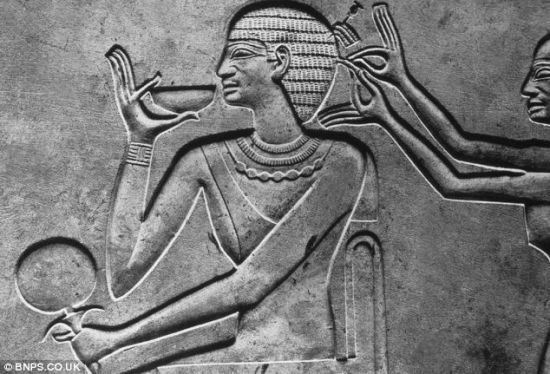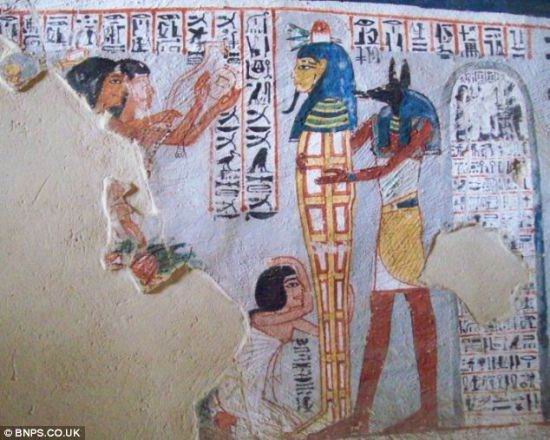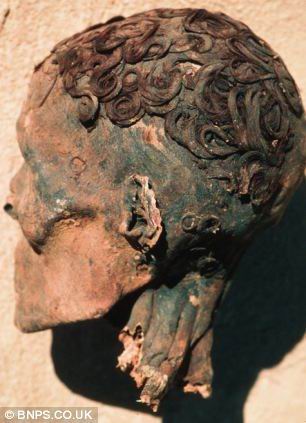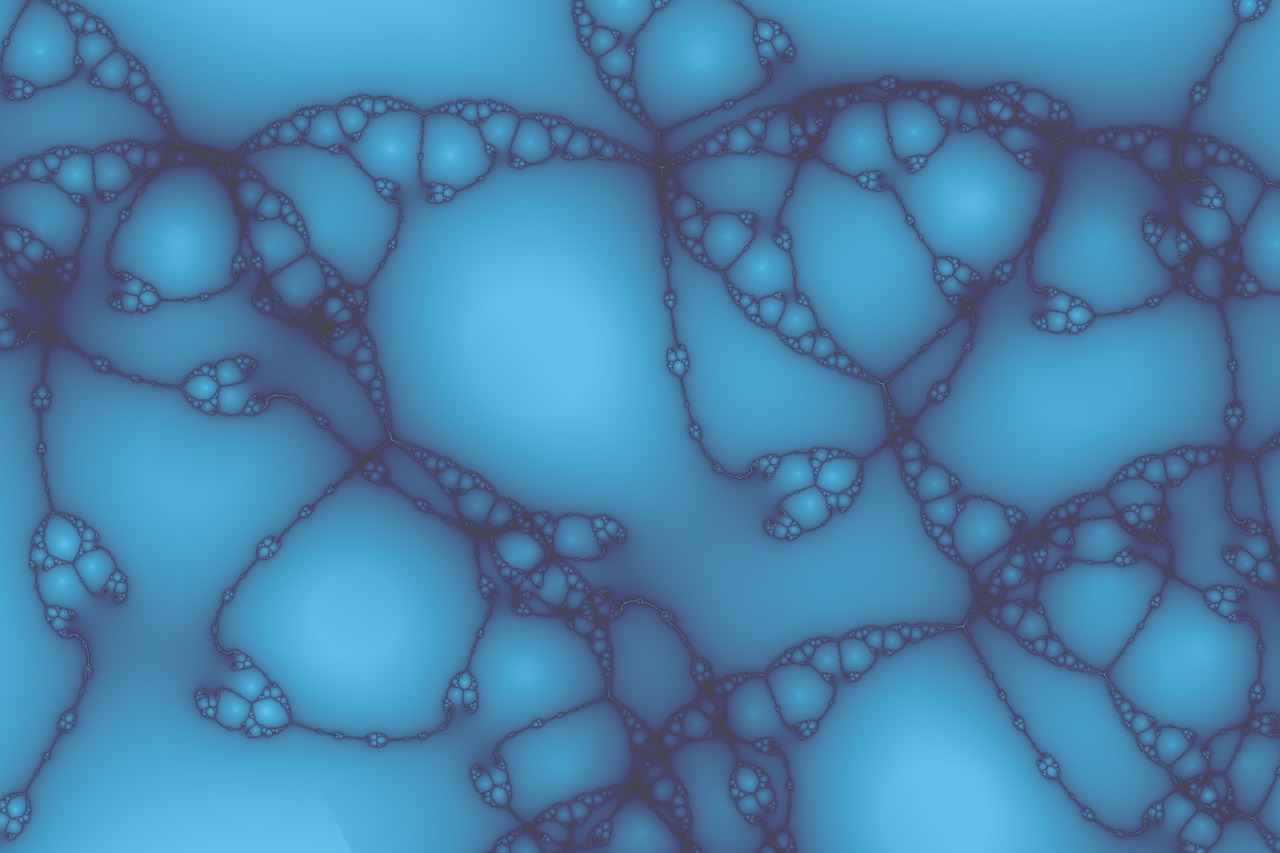用发胶给头发定型是很多人每天必做的功课,不过一项最新研究显示,几千年前的古埃及人似乎就已经开始这么做了。据英国《每日邮报》8月26日报道,科学家在研究了古埃及木乃伊的头发之后发现,古埃及人相当精通于美发技术。

研究人员并未在木乃伊的头发上发现树脂或者其他防腐物质,这说明整理头型与木乃伊身体的处理是分开的。
英国曼彻斯特大学的一个科研小组发现了这一有趣事实,该小组仔细研究了18具距今2300年到3500年的古埃及木乃伊。这些木乃伊男女皆有,年龄最大的58岁,最小的只有4岁。

这幅古埃及壁画中表现的就是人们为木乃伊整理头型的场景。
研究人员利用电子显微镜观察后发现,其中9具木乃伊的头发上包裹着一种油脂类物质,而且无论是人工制成的木乃伊还是自然形成的干尸均是如此。化验结果显示,这种物质中含有软脂酸和硬脂酸,却不含有树脂或者其他任何防腐物质。研究人员据此得出结论,古埃及人不仅使用这种油脂类物质给头发定型,还将其用于木乃伊的制作,以求死者在“另一个世界”保持美好的外形,而且美发的过程与木乃伊身体的处理是分开进行的。

3000多年过去了,这具木乃伊的头型还没乱。
现年29岁的娜塔莉•麦克里希博士是这个项目的负责人。她在接受采访时表示,这种古老的“发胶”很有可能是用动物脂肪制成的,但目前还无法断定。她说:“古埃及的这种油脂类物质相当于今天的发胶,简直惊人的相似。”
麦克李希博士推断,3000多年前的古埃及人就已经掌握了相当复杂的美发技术:“这些木乃伊的发型各不相同,其中一些还留着十分漂亮的卷发。我们在显微镜下观察发现,这些油脂类物质特别适合用来定型卷发。我们把其中一具留着短发的木乃伊戏称为‘玛丽莲•梦露’,另外一具木乃伊留着长一点的卷发,有点像蕾哈娜,而一些年轻男性也用这种油脂固定他们的分头。”
“由于一些自然形成的木乃伊头发上也发现了这种物质,因此我们认为古埃及人不仅是在制作木乃伊时候才为尸体美发,很多古埃及人平时也会用到它……不单单是法老,很多普通埃及人也会用到。你几乎可以想象到他们像我们现在一样整理头发,或是给头发打卷。”麦克李希介绍说。
生物探索推荐英文文章阅读:
The yummy mummies: How Egyptians used gel and curling tongs to look their best 3,500 years ago
Ancient Egyptians used hair gel to style their locks in everyday life, researchers have found.
A study of male and female mummies has found fashion-conscious Egyptians made use of a fat-based product to keep their hair in place.
They used the styling gel on both long and short hair, tried to curl their hair with tongs and even plaited it in hair extensions to lengthen their tresses.
It is thought they used these methods in both life and death, with corpses being styled to make sure they looked good in the afterlife.
The incredible discovery was made by archaeological scientists who studied hair samples of 18 male and female mummies, aged from four to 58 years old.
The team, from the KNH Centre of Biomedical Egyptology at the University of Manchester, was led by Dr Natalie McCreesh who studied the mummies as part of her PhD.
Using light and electron microscopes, they found that nine of the mummies had coated their hair in the fatty substance, which is thought to be a beauty product.
Some of the mummies, which were artificially preserved, show the gel was used to prepare the body for the afterlife.
But others, which were preserved naturally in dry sand, prove the product must also have been used in everyday life by the vain Egyptians.
Bizarrely, even in the artificially-preserved bodies the hair did not contain resins or embalming materials, suggesting the hair was styled separately to the mummification process.
The preserved bodies are between 3,500 and 2,300 years old, with most being excavated from a Greco-Roman cemetery in Dakhleh Oasis in the Western Desert.
Further study of the material, using gas chromatography mass spectrometry found the substance contained palmitic acid and stearic acid.
Dr McCreesh, 29, who is now a visiting scientist at the university, said research was unable to determine whether the gel was extracted from animals or plant, but was more likely to come from animals.
She added: 'The Ancient Egyptians used this fatty product just like we use gel today.
'The similarities are amazing.
'We knew that paintings in tombs have shown people with ungent cones on top of their heads, which were thought to be made of fats and scented resin.
'So we looked at hair on a selection of mummies to see if there was any trace of it.
'We found there was a fatty substance being used to hold hair in place.
'There was a variety of hair styles and cuts - some of the mummies had really beautiful curled hair.
'Under the microscope we could see the fat was used specifically on the curls, to hold them in place - just like people would now.
'One of the mummies had quite short hair and we joked she looked like Marilyn Monroe. Some others had longer curly hair, a little bit like Rihanna.
'Some of the younger men had their hair parted and slicked down with the product.
'We found the fat on the hair of nine mummies - the rest were very degraded and it wasn't possible to say for sure whether or not it was there.
'It's reasonable to think that some people would have styled their hair and others wouldn't - just like today.
'Because some of them were preserved naturally, we can see that they used it in everyday life as well as when they were being preserved in death.
'It probably wouldn't have been the very poorest, but it certainly wasn't restricted to just pharaohs or high nobility - ordinary people used it too.
'It's absolutely fascinating. You can almost imagine them tending their hair and setting their curls, just like we might today.'
The hair coating was found to contain fatty acids including palmitic acid and stearic acid, but it is hoped further research can help identify the exact recipe.
The research has now been published in the Journal of Archaeological Science.







